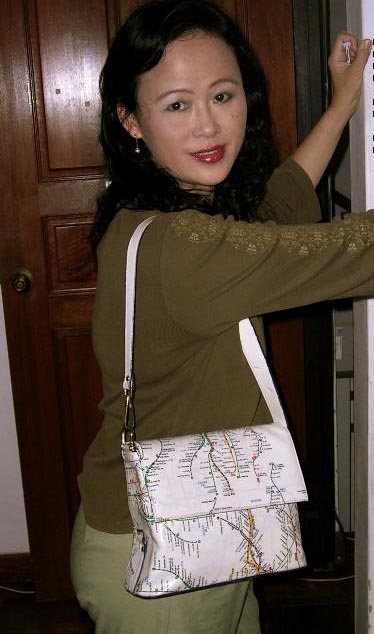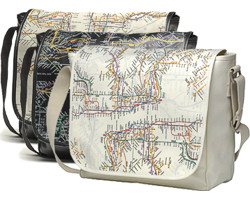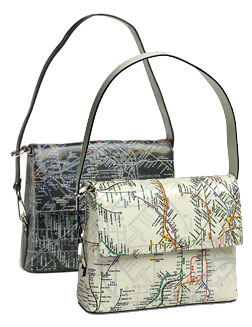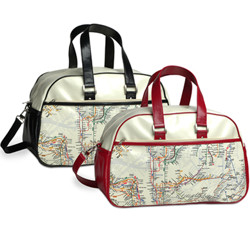tessa wong

context
Last Christmas, in a box of ‘NY Christmas goodies’ meant for my family, I packed a few expensive New York-made chocolate bars meant for my brothers and father, a Bloomingdale’s box of Kiehl’s moisturisers and toiletries, and a ‘subway handbag’ - i.e. a faux-leather handbag embossed with the New York subway map. The last two gifts were intended for my mother and sister respectively; unfortunately (or rather fortunately) I did not label the gifts, thinking that it would be obvious which gift was meant for whom.
When the box arrived, I received a call from my mother who was delighted by our gifts. She had opened the box and immediately pounced on the subway handbag; how did I know that she loved handbags? Before I could correct her about this mistake, she began to tell me excitedly how she had used it that very day when she went out for her daily errands, and how strangers in the supermarket and on the bus home had commented about her bag.
Recently I asked her to tell me how she has been using her handbag and how it has affected her life thus far. From her response I will be drawing out some issues which struck me.


agency: the ‘guesstimation’ of gift-giving
One thing about the context in which the gift was given that struck me was the intentionality of the gift, and how easily agency and intentionality is appropriated via reinterpretation of the gift (and the reason why it was given) by the recipient. It seems to me that throughout the readings we have done for this class that have talked about gift-giving and exchange, there is a presupposition that there is a mutual understanding between both parties of the gift-exchange process about the significance of the gift. In my case, there was a situation of mixed signals where that specific gift was not intended for that specific recipient, although the intention was certainly there and understood by both parties in the process. With the lack of communication, this subsequently resulted in a claiming of a gift in order to enact the intention—thus here we see agency comes first, not the gift; agency does not issue forth from the gift, but is passed between recipients and the gift becomes the physical manifestation of that. More importantly, agency later becomes appropriated as well. Just as the gift is appropriated for the recipient’s own means and ends (as seen in how my mother uses her handbag), agency and intention here becomes appropriated as well. What is meant as a simple gift to my mother as an expression of my love or as Weiner calls it, ‘obligatory devotion’ (reference here), becomes a gift that not only becomes a symbol of our relationship, but also as a symbol of prestige for my mother.prestige and relationships
Note the following excerpt from my mother’s e-mail:I am so proud of this bag! Firstly. its a gift from my beloved daughter all the way from NY. I love it a lot though its original intention for its recipient is otherwise [sic]. I use it every time I get out of the house when I go to the market, shopping, church, outings.... It has become a conversational piece even on the bus and train. People standing next to me will say, "Hey, this is a cute bag. With all the MRT [i.e., Mass Rapid Transit, the Singaporean subway system.] maps on it! You can never get lost!" or "Are you afraid you’ll lose your way in Singapore... why do you carry a map on your bag?" I will say "Hey, look closely. It’s the NY subway... and the ‘yak-yak’ begins:
1) "This is a Christmas gift from my 2nd daughter all the way from NY. I will need this when I visit her in NY so that I won't get lost." And then the conversation will follow, especially with strangers on the bus/train, "Oh, you mean she stays in NY?", "Er, no. She is finishing her master’s degree this year and will be back soon.” “Oh, how many children do you have?" and the chit-chat goes on until I alight.
2) And I will use the bag to show my friends where you are staying in New York. Near a subway station on Manhattan!reciprocity and identity
Let us now look at another part of her response:
Here we see that reciprocity is understood in terms of feelings and emotions, and more importantly, it shows how my mother sacralises the object. My mum through an attachment of feelings to the object, chooses to convert it from alienable commodity (a piece of mass-produced MTA merchandise) into inalienable gift. It becomes sacred because, as mentioned, it becomes the embodiment of her relationship to her daughter. This object’s potentiality of exchange has ended when it has come into my mother’s possession: it becomes a site for ‘the objectification of transcendence’ as Weiner would put it (Miller, 94).
But at the same time she appropriates it for herself, it becomes ‘her’ and ‘her’ accessory, and absorbs it more into her identity as a person. One could draw parallels with technology and my previous presentation on the use of technology as part of identity, elevating oneself into culturally relevant realms of society (and thus, prestige). Fashion, in the end, is an extension of personality, so to speak. And to borrow Gell’s idea of exuviaie, one could see clothing accessories as external objects which can be seen in relation to ourselves. Thus, what is intrinsic to ourselves becomes ‘flaked off’ in a sense.from america with love
Finally, one thing that struck me about this episode was how people mistook the map of New York’s subway system as that of Singapore’s. As mentioned earlier, it is a mapping of a familiar elsewhere, and taken out of its context becomes a status symbol. It is significant that people mistook it for the Singaporean subway map at first – if there was no subway system in Singapore, this mistake would not have been made. If there had been no constant modernisation of the country in the last 30 years, no light-year jump from the ‘3rd World’ to ‘1st’, people would have recognised the bag as immediately foreign. So this strange familiarity of a technologically advanced city that has reached a certain point in its modernisation—as represented by its infrastructure, and a mapping of this infrastructure—is seen as a status symbol too. Not only the object but its aesthetic design is also a symbol of prestige in its own way. Thus, the qualitiative agency of claiming prestige using the object derives not only from its context—the reason for the gift-giving, the relationship which is it embodies—but its aesthetic form and design as well.
Gell, Alfred. 1998. Art and Agency: An Anthropological Theory. Clarendon Press, New York.
Godelier, Maurice. 1999. The Enigma of the Gift. University of Chicago Press.
Mauss, Marcel. 1990. The Gift. W. W. Norton, New York.
Miller, Daniel. 2001. Alienable gifts and inalienable commodities. In The Empire of Things, edited by Fred R. Myers, pp.91-115. School of American Research Press, Santa Fe.